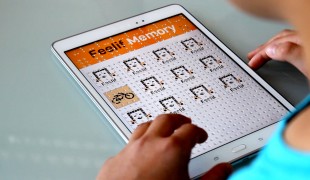- 6099
- 344
- 3
- 7
- 4
- Help Ukraine
About the solution
“It’s my first year in a school that takes part in a project that integrates students with visual impairments into public schools. We have three students, and from daily interactions with them I was very curious and had a lot of questions. What letters they use, and how they communicate with others. I was amazed by the size of their large books. This motivated me to learn more about their world and search for answers", the young girl explained.
Talah’s solution differs from Braille because it requires smaller spacing when printing due to the use of diacritics being placed above the letters instead of writing it as a completely new and separate letter, as is the case with Braille. This new system follows a pattern that helps save time and effort, so it’s easier to learn and faster to memorize. The diacritical marks have different geometrical shapes from the letters’ shapes, and the geometrical shapes are written in small forms above the letters, in contrast to braille, and the marks are written as new letters.
“The Arabic alphabet consists of 28 letters. Sets of nine-quadrant-grids are used to represent the different letters. They are divided into three grids, which are used recurrently with the only difference being the absence or presence of one or two dots within the shapes. The letters are divided into three groups, and the nine basic shapes are used in all three, with different uses of dots each time,” she expressed.
The inventor has been working on this project for two years and she hopes that it can help people from all over the world. She already applied for a patent and is has plans to publish her work.
“Then, I’ll work on publishing this writing system to spread it and help people with visual impairments. I definitely want to apply the structure of the writing system to more languages that may or may not include diacritics to help it expand”, Talah said.
The student won 3rd place at Intel ISEF 2018 in Pennsylvania, USA, in May 2018.
Abualnaja’s project led her to win third place at the Intel ISEF 2018 in Pennsylvania, Pittsburgh in May.
Adapted from: https://bit.ly/2sGkeE0
这些解决方案不应包括使用药物,化学品或生物制品(包括食品);创伤性设备;冒犯性的,商业或内在危险的内容。该解决方案未经医学验证。请谨慎进行!如果您有任何疑问,请咨询健康专家。
DISCLAIMER: This story was written by someone who is not the author of the solution, therefore please be advised that, although it was written with the utmost respect for the innovation and the innovator, there can be some incorrect statements. If you find any errors please contact the patient Innovation team via info@patient-innovation.com
-
-
327
-
0
-
5199

Girl invents toy to cope with dyslexia
Reading
Writing (letters, songs, peoms)
Studying
dyslexia
Visual Impairment
Hearing Disorders
Educational/Leisure device (book, toy, game...)
Vision problems
Difficulty speaking or understanding speech
Cognitive impairment
Memory loss
Confusion
Managing Neurological Disorders
Improving Speech and Communication
Child and Adolescent Psychiatry
Neurology
Pediatrics
United Kingdom
-
-
-
361
-
0
-
6198

Woman invents a tablet for blind people
-
-
-
596
-
2
-
10745

Feelif is a multimedia device for blind and visually impaired people
COMMUNICATION: Communicating, whether by speaking, listening, or other means
Reading
Video gaming
Blindness
Visual Impairment
Congenital Deafness
Hearing Disorders
App (Including when connected with wearable)
Videogame
Educational/Leisure device (book, toy, game...)
Vision problems
Hearing loss or ringing in the ears (tinnitus)
Managing Neurological Disorders
Improving Speech and Communication
General and Family Medicine
Medical Genetics
Neurology
Ophthalmology
Otorhinolaryngology
Pediatrics
Slovenia
-
 zh
zh
DakotaEverard • Fri, 06/22/2018 - 16:06